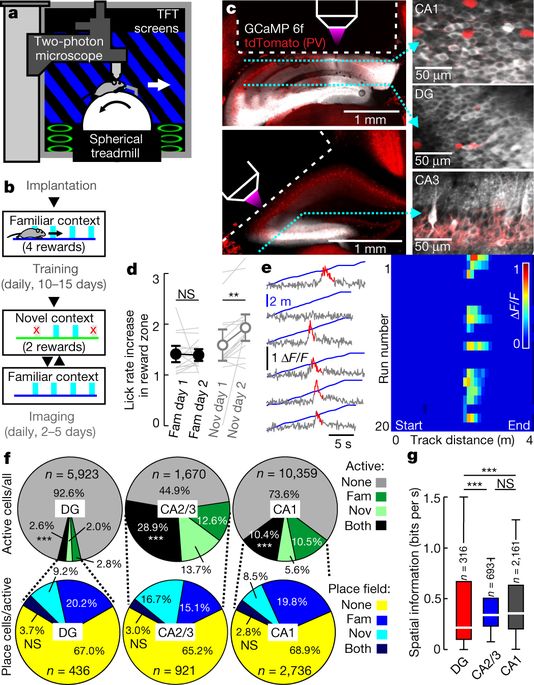Our official English website, www.x-mol.net, welcomes your feedback! (Note: you will need to create a separate account there.)
Parallel emergence of stable and dynamic memory engrams in the hippocampus
Nature ( IF 64.8 ) Pub Date : 2018-06-01 , DOI: 10.1038/s41586-018-0191-2 Thomas Hainmueller 1, 2, 3 , Marlene Bartos 1
Nature ( IF 64.8 ) Pub Date : 2018-06-01 , DOI: 10.1038/s41586-018-0191-2 Thomas Hainmueller 1, 2, 3 , Marlene Bartos 1
Affiliation

|
During our daily life, we depend on memories of past experiences to plan future behaviour. These memories are represented by the activity of specific neuronal groups or ‘engrams’1,2. Neuronal engrams are assembled during learning by synaptic modification, and engram reactivation represents the memorized experience1. Engrams of conscious memories are initially stored in the hippocampus for several days and then transferred to cortical areas2. In the dentate gyrus of the hippocampus, granule cells transform rich inputs from the entorhinal cortex into a sparse output, which is forwarded to the highly interconnected pyramidal cell network in hippocampal area CA33. This process is thought to support pattern separation4 (but see refs. 5,6). CA3 pyramidal neurons project to CA1, the hippocampal output region. Consistent with the idea of transient memory storage in the hippocampus, engrams in CA1 and CA2 do not stabilize over time7–10. Nevertheless, reactivation of engrams in the dentate gyrus can induce recall of artificial memories even after weeks2. Reconciliation of this apparent paradox will require recordings from dentate gyrus granule cells throughout learning, which has so far not been performed for more than a single day6,11,12. Here, we use chronic two-photon calcium imaging in head-fixed mice performing a multiple-day spatial memory task in a virtual environment to record neuronal activity in all major hippocampal subfields. Whereas pyramidal neurons in CA1–CA3 show precise and highly context-specific, but continuously changing, representations of the learned spatial sceneries in our behavioural paradigm, granule cells in the dentate gyrus have a spatial code that is stable over many days, with low place- or context-specificity. Our results suggest that synaptic weights along the hippocampal trisynaptic loop are constantly reassigned to support the formation of dynamic representations in downstream hippocampal areas based on a stable code provided by the dentate gyrus.Imaging of hippocampal neuron activity in mice performing a memory task across several days identifies both stable and dynamic memory engrams.
中文翻译:

海马中稳定和动态记忆印迹的并行出现
在日常生活中,我们依靠对过去经历的记忆来规划未来的行为。这些记忆由特定神经元组或“印迹”1,2 的活动表示。在学习过程中通过突触修饰组装神经元印迹,而印迹重新激活代表了记忆的经验。有意识记忆的印迹最初会在海马体中储存几天,然后转移到皮层区域 2。在海马齿状回中,颗粒细胞将来自内嗅皮层的丰富输入转化为稀疏输出,然后转发到海马区 CA33 中高度互连的锥体细胞网络。这个过程被认为支持模式分离4(但参见参考文献 5,6)。CA3 锥体神经元投射到海马输出区 CA1。与海马体中瞬时记忆存储的想法一致,CA1 和 CA2 中的印迹不会随着时间的推移而稳定7-10。然而,即使在几周后,齿状回中印迹的重新激活也可以诱发人工记忆的回忆。这种明显的悖论的和解将需要在整个学习过程中从齿状回颗粒细胞中进行记录,到目前为止,这种情况还没有进行超过一天 6,11,12。在这里,我们在头部固定小鼠中使用慢性双光子钙成像,在虚拟环境中执行多日空间记忆任务,以记录所有主要海马亚区的神经元活动。而 CA1-CA3 中的锥体神经元在我们的行为范式中显示出精确且高度特定于上下文但不断变化的学习空间场景的表示,齿状回中的颗粒细胞有一个空间代码,在很多天里都是稳定的,具有较低的位置或上下文特异性。我们的结果表明,基于齿状回提供的稳定代码,海马三突触环上的突触权重不断被重新分配,以支持下游海马区动态表征的形成。 几天内执行记忆任务的小鼠海马神经元活动的成像识别稳定和动态记忆印迹。
更新日期:2018-06-01
中文翻译:

海马中稳定和动态记忆印迹的并行出现
在日常生活中,我们依靠对过去经历的记忆来规划未来的行为。这些记忆由特定神经元组或“印迹”1,2 的活动表示。在学习过程中通过突触修饰组装神经元印迹,而印迹重新激活代表了记忆的经验。有意识记忆的印迹最初会在海马体中储存几天,然后转移到皮层区域 2。在海马齿状回中,颗粒细胞将来自内嗅皮层的丰富输入转化为稀疏输出,然后转发到海马区 CA33 中高度互连的锥体细胞网络。这个过程被认为支持模式分离4(但参见参考文献 5,6)。CA3 锥体神经元投射到海马输出区 CA1。与海马体中瞬时记忆存储的想法一致,CA1 和 CA2 中的印迹不会随着时间的推移而稳定7-10。然而,即使在几周后,齿状回中印迹的重新激活也可以诱发人工记忆的回忆。这种明显的悖论的和解将需要在整个学习过程中从齿状回颗粒细胞中进行记录,到目前为止,这种情况还没有进行超过一天 6,11,12。在这里,我们在头部固定小鼠中使用慢性双光子钙成像,在虚拟环境中执行多日空间记忆任务,以记录所有主要海马亚区的神经元活动。而 CA1-CA3 中的锥体神经元在我们的行为范式中显示出精确且高度特定于上下文但不断变化的学习空间场景的表示,齿状回中的颗粒细胞有一个空间代码,在很多天里都是稳定的,具有较低的位置或上下文特异性。我们的结果表明,基于齿状回提供的稳定代码,海马三突触环上的突触权重不断被重新分配,以支持下游海马区动态表征的形成。 几天内执行记忆任务的小鼠海马神经元活动的成像识别稳定和动态记忆印迹。



























 京公网安备 11010802027423号
京公网安备 11010802027423号